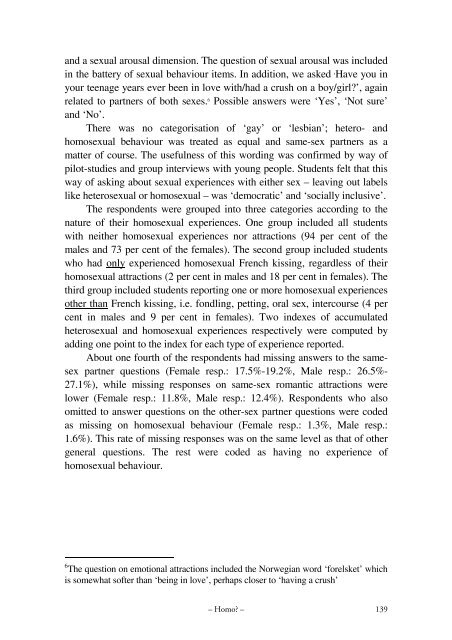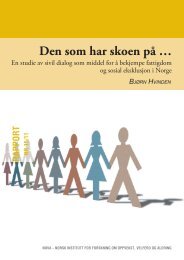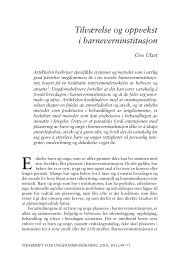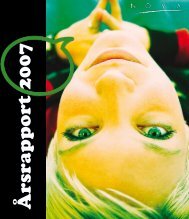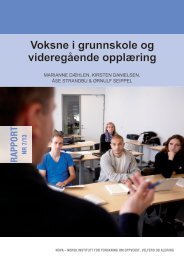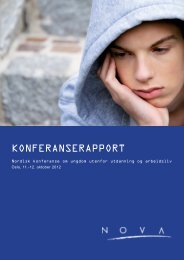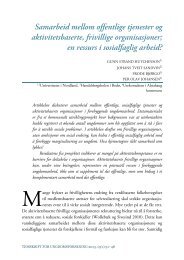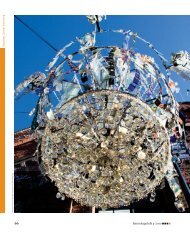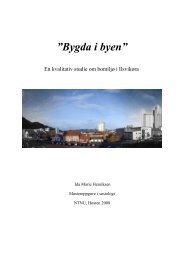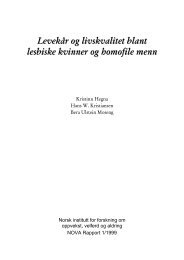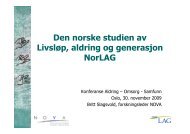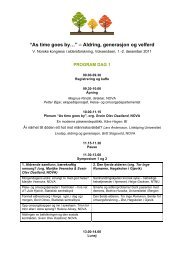Betydningen av seksuell erfaring, tiltrekning og identitet for ...
Betydningen av seksuell erfaring, tiltrekning og identitet for ...
Betydningen av seksuell erfaring, tiltrekning og identitet for ...
Create successful ePaper yourself
Turn your PDF publications into a flip-book with our unique Google optimized e-Paper software.
and a sexual arousal dimension. The question of sexual arousal was included<br />
in the battery of sexual beh<strong>av</strong>iour items. In addition, we asked ‘H<strong>av</strong>e you in<br />
your teenage years ever been in love with/had a crush on a boy/girl?’, again<br />
related to partners of both sexes. 6 Possible answers were ‘Yes’, ‘Not sure’<br />
and ‘No’.<br />
There was no categorisation of ‘gay’ or ‘lesbian’; hetero- and<br />
homosexual beh<strong>av</strong>iour was treated as equal and same-sex partners as a<br />
matter of course. The usefulness of this wording was confirmed by way of<br />
pilot-studies and group interviews with young people. Students felt that this<br />
way of asking about sexual experiences with either sex – le<strong>av</strong>ing out labels<br />
like heterosexual or homosexual – was ‘democratic’ and ‘socially inclusive’.<br />
The respondents were grouped into three categories according to the<br />
nature of their homosexual experiences. One group included all students<br />
with neither homosexual experiences nor attractions (94 per cent of the<br />
males and 73 per cent of the females). The second group included students<br />
who had only experienced homosexual French kissing, regardless of their<br />
homosexual attractions (2 per cent in males and 18 per cent in females). The<br />
third group included students reporting one or more homosexual experiences<br />
other than French kissing, i.e. fondling, petting, oral sex, intercourse (4 per<br />
cent in males and 9 per cent in females). Two indexes of accumulated<br />
heterosexual and homosexual experiences respectively were computed by<br />
adding one point to the index <strong>for</strong> each type of experience reported.<br />
About one fourth of the respondents had missing answers to the samesex<br />
partner questions (Female resp.: 17.5%-19.2%, Male resp.: 26.5%-<br />
27.1%), while missing responses on same-sex romantic attractions were<br />
lower (Female resp.: 11.8%, Male resp.: 12.4%). Respondents who also<br />
omitted to answer questions on the other-sex partner questions were coded<br />
as missing on homosexual beh<strong>av</strong>iour (Female resp.: 1.3%, Male resp.:<br />
1.6%). This rate of missing responses was on the same level as that of other<br />
general questions. The rest were coded as h<strong>av</strong>ing no experience of<br />
homosexual beh<strong>av</strong>iour.<br />
6 The question on emotional attractions included the Norwegian word ‘<strong>for</strong>elsket’ which<br />
is somewhat softer than ‘being in love’, perhaps closer to ‘h<strong>av</strong>ing a crush’<br />
– Homo? – 139


